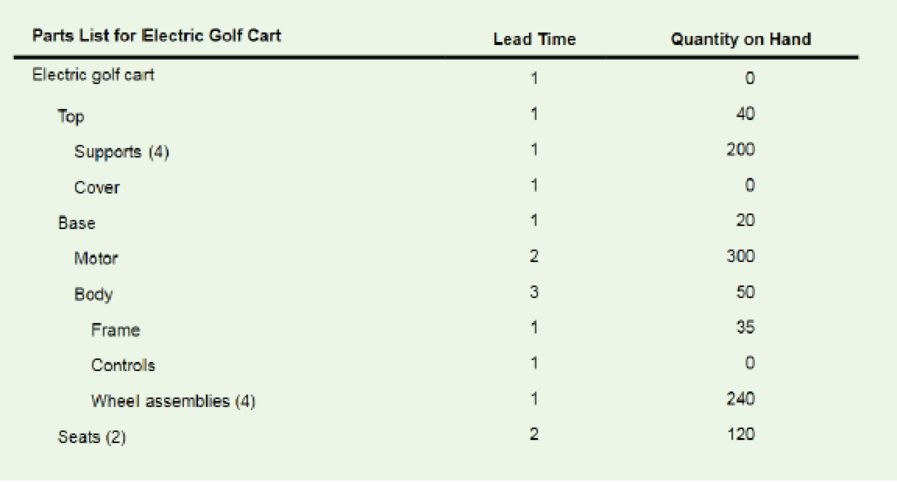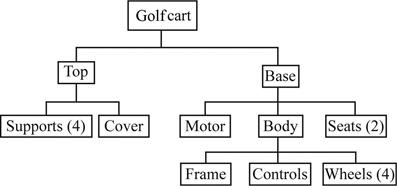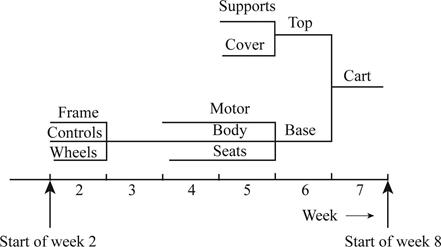
Concept explainers
A firm that produces electric golf carts has just received an order for 200 carts, which must be ready for delivery at the start of week 8. Information concerning the product structure, lead times, and quantities on hand is shown in the following table. Use this information to do each of the following:
a. Construct a product tree.
b. Construct an assembly time chart.
c. Develop a material requirements plan that will provide 200 golf carts by week 8 assuming lot-for-lot ordering.

a)
To construct: A product tree
Introduction: Materials Requirement Planning (MRP) is the planning or scheduling system, which can be used in the manufacturing process. It is used to plan the number of items required to produce one unit of finished goods (end item).
Explanation of Solution
Given information:

Construct a product tree:

b)
To construct: An assembly time chart
Introduction: Materials Requirement Planning (MRP) is the planning or scheduling system, which can be used in the manufacturing process. It is used to plan the number of items required to produce one unit of finished goods (end item).
Explanation of Solution
Given information:

Construct an assembly time chart:

c)
To prepare: Materials Requirement planning using the provided information.
Introduction: Materials Requirement Planning (MRP) is the planning or scheduling system, which can be used in the manufacturing process. It is used to plan the number of items required to produce one unit of finished goods (end item).
Explanation of Solution
Given information:
The company needs to provide 200 golf carts by week 8.

Develop a material requirement planning for golf cart:

- It is given that the company needs to provide 200 golf carts by week 8.
- Beginning inventory is 0 units.
- Net requirement can be calculated by subtracting the projected on-hand from the gross requirement. Hence, the net requirement is 200 units in week 8 (200-0).
- Planned order release is the order given by the company and planned order receipts is the order received by the firm.
- Lead-time is given as 1 week. Company requires 200 units in the beginning of Week 8. Hence, they need to order for 200 units (as the lot size is lot-for-lot) on previous week (as the lead-time is 1 week). Thus, company need to order the required units in week 7.
Develop a material requirement planning for top:

- Golf cart is the parent for top. Hence, the planned order release of the golf cart would be the gross requirement of the top. As number of units required is 1 for top, the planned order release row of golf cart should be multiplied with 1 to attain the gross requirement column of top.
- Beginning inventory is 40 units.
- Net requirement can be calculated by subtracting the projected on-hand from the gross requirement. Hence, the net requirement is 160 units in week 7 (200-40).
- Planned order release is the order given by the company and planned order receipts is the order received by the firm.
- Lead-time is given as 1 week. Company requires 160 units in the beginning of Week 7. Hence, they need to order for 160 units (as the lot size is lot-for-lot) on previous week (as the lead-time is 1 week). Thus, company need to order the required units in week 6.
- Projected on hand inventory for week 8 is 0 units. Calculation is as follows:
Develop a material requirement planning for supports (4):

- Top is the parent for supports. Hence, the planned order release of the top would be the gross requirement of the supports. As number of units required is 4 for supports, the planned order release row of top should be multiplied with 4 to attain the gross requirement column of support.
- Beginning inventory is 200 units.
- Net requirement can be calculated by subtracting the projected on-hand from the gross requirement. Hence, the net requirement is 440 units in week 6 (640-200).
- Planned order release is the order given by the company and planned order receipts is the order received by the firm.
- Lead-time is given as 1 week. Company requires 440 units in the beginning of Week 6. Hence, they need to order for 440 units (as the lot size is lot-for-lot) on previous week (as the lead-time is 1 week). Thus, company need to order the required units in week 5.
- Projected on hand inventory for week 7 is 0 units. Calculation is as follows:
Develop a material requirement planning for cover:

- Top is the parent for cover. Hence, the planned order release of the top would be the gross requirement of the cover. As number of units required is 1 for cover, the planned order release row of top should be multiplied with 1 to attain the gross requirement column of cover.
- Beginning inventory is 0 units.
- Net requirement can be calculated by subtracting the projected on-hand from the gross requirement. Hence, the net requirement is 160 units in week 6 (160-0).
- Planned order release is the order given by the company and planned order receipts is the order received by the firm.
- Lead-time is given as 1 week. Company requires 160 units in the beginning of Week 6. Hence, they need to order for 160 units (as the lot size is lot-for-lot) on previous week (as the lead-time is 1 week). Thus, company need to order the required units in week 5.
Develop a material requirement planning for base:

- Golf cart is the parent for base. Hence, the planned order release of the golf cart would be the gross requirement of the base. As number of units required is 1 for base, the planned order release row of golf cart should be multiplied with 1 to attain the gross requirement column of base.
- Beginning inventory is 20 units.
- Net requirement can be calculated by subtracting the projected on-hand from the gross requirement. Hence, the net requirement is 180 units in week 7 (200-20).
- Planned order release is the order given by the company and planned order receipts is the order received by the firm.
- Lead-time is given as 1 week. Company requires 180 units in the beginning of Week 7. Hence, they need to order for 180 units (as the lot size is lot-for-lot) on previous week (as the lead-time is 1 week). Thus, company need to order the required units in week 6.
- Projected on hand inventory for week 8 is 0 units. Calculation is as follows:
Develop a material requirement planning for motor:

- Base is the parent for motor. Hence, the planned order release of the base would be the gross requirement of the motor. As number of units required is 1 for motor, the planned order release row of base should be multiplied with 1 to attain the gross requirement column of motor.
- Beginning inventory is 300 units.
- Gross requirement for week 6 is 180 units. As the beginning inventory is sufficient to satisfy the demand, there is no necessary to place an order.
- Projected on hand inventory for week 7 is 120 units. Calculation is as follows:
Develop a material requirement planning for body:

- Base is the parent for body. Hence, the planned order release of the base would be the gross requirement of the body. As number of units required is 1 for body, the planned order release row of base should be multiplied with 1 to attain the gross requirement column of body.
- Beginning inventory is 50 units.
- Net requirement can be calculated by subtracting the projected on-hand from the gross requirement. Hence, the net requirement is 130 units in week 6 (180-50).
- Planned order release is the order given by the company and planned order receipts is the order received by the firm.
- Lead-time is given as 3 weeks. Company requires 130 units in the beginning of Week 6. Hence, they need to order for 130 units (as the lot size is lot-for-lot) before three weeks (as the lead-time is 3 weeks). Thus, company need to order the required units in week 3.
- Projected on hand inventory for week 7 is 0 units. Calculation is as follows:
Develop a material requirement planning for seats (2):

- Base is the parent for seats. Hence, the planned order release of the base would be the gross requirement of the seats. As number of units required is 1 for seats, the planned order release row of base should be multiplied with 1 to attain the gross requirement column of seats.
- Beginning inventory is 120 units.
- Net requirement can be calculated by subtracting the projected on-hand from the gross requirement. Hence, the net requirement is 240 units in week 6 (360-120).
- Planned order release is the order given by the company and planned order receipts is the order received by the firm.
- Lead-time is given as 2 weeks. Company requires 240 units in the beginning of Week 6. Hence, they need to order for 240 units (as the lot size is lot-for-lot) before two weeks (as the lead-time is 2 weeks). Thus, company need to order the required units in week 4.
- Projected on hand inventory for week 7 is 0 units. Calculation is as follows:
Develop a material requirement planning for frame:

- Body is the parent for frame. Hence, the planned order release of the body would be the gross requirement of the frame. As number of units required is 1 for frame, the planned order release row of body should be multiplied with 1 to attain the gross requirement column of frame.
- Beginning inventory is 35 units.
- Net requirement can be calculated by subtracting the projected on-hand from the gross requirement. Hence, the net requirement is 95 units in week 3 (130-35).
- Planned order release is the order given by the company and planned order receipts is the order received by the firm.
- Lead-time is given as 1 week. Company requires 95 units in the beginning of Week 3. Hence, they need to order for 95 units (as the lot size is lot-for-lot) on previous week (as the lead-time is 1 week). Thus, company need to order the required units in week 2.
- Projected on hand inventory for week 4 is 0 units. Calculation is as follows:
Develop a material requirement planning for controls:

- Body is the parent for controls. Hence, the planned order release of the body would be the gross requirement of the controls. As number of units required is 1 for controls, the planned order release row of body should be multiplied with 1 to attain the gross requirement column of controls.
- Beginning inventory is 0 units.
- Net requirement can be calculated by subtracting the projected on-hand from the gross requirement. Hence, the net requirement is 130 units in week 3 (130-0).
- Planned order release is the order given by the company and planned order receipts is the order received by the firm.
- Lead-time is given as 1 week. Company requires 130 units in the beginning of Week 3. Hence, they need to order for 130 units (as the lot size is lot-for-lot) on previous week (as the lead-time is 1 week). Thus, company need to order the required units in week 2.
Develop a material requirement planning for wheel assemblies (4):

- Body is the parent for wheel assemblies. Hence, the planned order release of the body would be the gross requirement of the wheel assemblies. As number of units required is 4 for wheel assemblies, the planned order release row of body should be multiplied with 4 to attain the gross requirement column of wheel assemblies.
- Beginning inventory is 240 units.
- Net requirement can be calculated by subtracting the projected on-hand from the gross requirement. Hence, the net requirement is 280 units in week 3 (520-240).
- Planned order release is the order given by the company and planned order receipts is the order received by the firm.
- Lead-time is given as 1 week. Company requires 280 units in the beginning of Week 3. Hence, they need to order for 280 units (as the lot size is lot-for-lot) on previous week (as the lead-time is 1 week). Thus, company need to order the required units in week 2.
- Projected on hand inventory for week 4 is 0 units. Calculation is as follows:
Want to see more full solutions like this?
Chapter 12 Solutions
Operations Management (McGraw-Hill Series in Operations and Decision Sciences)
Additional Business Textbook Solutions
Business in Action (8th Edition)
Operations Management, Binder Ready Version: An Integrated Approach
Operations and Supply Chain Management 9th edition
Principles Of Operations Management
Operations Management: Sustainability and Supply Chain Management (12th Edition)
- A firm that produces electric golf carts has just received an order for 200 carts, which must be ready for delivery at the start of week 8. Information concerning the product structure, lead times, and quantities on hand is shown in the following table. Use this information to do each of the following: a. Develop a material requirements plan that will provide 200 golf carts by week 8, assuming lot-for-lot ordering. (Excel)arrow_forwardA partially completed inventory record for the motor subassembly is shown in Figure.a. Complete the last three rows of the record by using the L4L rule.b. Complete the last three rows of the record by using the POQ rule with P = 2.c. Complete the last three rows of the record by using the POQ rule with P = 2.d. If it costs the company $1 to hold a unit in inventory from one week to the next, and the cost to release an order is $50, which of the lot sizing rules used above will provide the lowest inventory holding + order release cost?arrow_forwardThe following table lists the components needed to assemble an end item, the manufacturing or purchase lead times (in weeks) for typical lot sizes, amount on hand, and the direct components of each item and, in brackets, the number of each component for each parent. Item Lead Time Amount onHand DirectComponents End item 1 - L(2), C(1), K(3) L 1 8 B(2), J(3) C 3 14 G(2), B(2) K 3 18 H(4), B(2) B 1 24 J 4 34 G 3 38 H 3 - a. This part of the question is not part of your Connect assignment.b. If 44 units of the end item are to be assembled, how many additional units of B are needed? (You don’t need to develop the MRP tables.)Additional units c. An order for 44 units of the end item is scheduled to be shipped at the start of week 8. What is the latest week that the components of the order can be started and the order still be ready to ship on time? (You don’t need to develop the MRP tables.)The latest weekarrow_forward
- Draw a product structure and a indexed bill of materials for the following product: the final product 'A' consists of a subassembly 'B' and two subassemblies 'C'. Subassembly 'B' consists of one component 'D' and two components 'E'. Subassembly 'C' consists of one component 'E', one 'F', and two 'G'.arrow_forwardThe following table lists the components needed to assemble an end item, the manufacturing or purchase lead times (in weeks) for typical lot sizes, amount on hand, and the direct components of each item and, in brackets, the number of each component for each parent. Item Lead Time Amount onHand DirectComponents End item 1 - L(2), C(1), K(3) L 2 14 B(2), J(3) C 3 30 G(2), B(2) K 1 25 H(4), B(2) B 4 15 J 2 10 G 4 5 H 2 - a. Not available in Connect.b. If 46 units of the end item are to be assembled, how many additional units of B are needed? (You don’t need to develop the MRP tables.)Additional units ____ c. An order for 46 units of the end item is scheduled to be shipped at the start of week 11. What is the latest week that the components of the order can be started and the order still be ready to ship on time? (You don’t need to develop the MRP tables.)The latest week ____arrow_forwarda. One hundred twenty units of end item Z are needed at the beginning of week 7. Prepare a material requirements plan for component C. Take into account that on hand there are 40 units of Z,70 units of A, 100 units of B, and 30 units of C. Also, there is a scheduled receipt of 20 units ofcomponent C in week 4. Lead times are two weeks for Z and B, and one week for the other components. Lot-for-lot ordering will be used for all items b. Ninety-five units of end item E are needed at the beginning of week 7. Prepare a material requirements plan for component D. Take into account that 5 units of E are currently on hand, as well as50 units of B, 100 units of C, and 80 units of D. Also, 30 units of C have been outsourced and areexpected to arrive in week 4. Lead times are two weeks for E and C, and one week for the othercomponents. Assume lot-for-lot ordering except for D, where multiples of 40 must be used.arrow_forward
- Product A is assembled from two units of S1 and threeunits of S2. S1 is made of one unit of C1, four units of C2,and one unit of C3. S2 is made of three units of C2 and twounits of C3.a. Draw a product structure diagram for product A.b. How many C3’s are needed to fill an order for 100 A’s?c. Assume no inventory on hand, products take one day to assemble, subassemblies take two days and compo-nents take three days. When should an order be re-leased for C3 if the 100 A’s are needed by day 7?arrow_forwardAs the production planner for Xiangling Hu Products, Inc., you have been given a bill of material for a bracket that is made up of a base, 2 springs, and 4 clamps. The base is assembled from 1 clamp and 1 housing. Each clamp has 1 handle and 1 casting. Each housing has 2 bearings and 1 shaft. There is no inventory on hand. This exercise contains only parts b and c. Part 2 The product structure is as follows: Bracket Base(1) Clamp(1) Handle(1) Casting(1) Spring(2) Housing(1) Shaft(1) Clamp(4) Bearing(2) Handle(1) Casting(1) Part 3 b) Determine the gross quantities needed of each item if you are to assemble 100 brackets. Base: enter your response here units (enter your response as a whole number). Spring: enter your response here units (enter your response as a whole number). Clamp: enter your response here units (enter your response as a whole number). Housing: enter your response here units (enter your…arrow_forwardAs the production planner for Xiangling Hu Products, Inc., you have been given a bill of material for a bracket that is made up of a base, 2 springs, and 3 clamps. The base is assembled from 1 clamp and 2 housings. Each clamp has 1 handle and 1 casting. Each housing has 2 bearings and 2 shafts. There is no inventory on hand. This exercise contains only parts b and c. Part 2 The product structure is as follows: Bracket Base(1) Clamp(1) Handle(1) Casting(1) Spring(2) Housing(2) Shaft(2) Clamp(3) Bearing(2) Handle(1) Casting(1) Part 3 b) Determine the gross quantities needed of each item if you are to assemble 125 brackets. Base: 33 units (enter your response as a whole number). Spring: enter your response here units (enter your response as a whole number). Clamp: enter your response here units (enter your response as a whole number). Housing: enter your response here units (enter your response as a whole…arrow_forward
- As the production planner for Xiangling Hu Products, Inc., you have been given a bill of material for a bracket that is made up of a base, 2 springs, and 4 clamps. The base is assembled from 1 clamp and 2housings. Each clamp has 1 handle and 1 casting. Each housing has 2 bearings and 1 shaft. There is no inventory on hand. Your boss at Xiangling Hu Products, Inc., has just provided you with the schedule and lead times for the bracket. The unit is to be prepared in week 12.The lead times for the components are bracket (1 week), base (1 week), spring (1 week), clamp (1 week), housing (3weeks), handle (2weeks), casting (4weeks), bearing (1 week), and shaft (1 week). Part 3 b) In what week do you need to start the castings? The castings need to be started in week enter your response here (enter your response as a whole number).arrow_forwardThe following table lists the components needed to assemble an end item, lead times (in weeks), and quantities on hand. Item Lead Time Amount on Hand Direct Components End 2 0 L(2), C(1), K(3) L 2 11 B(2), J(3) C 3 15 G(2), B(2) K 3 20 H(4), B(2) B 2 25 J 3 34 G 3 3 H 2 0 Click here for the Excel Data File a. If 43 units of the end item are to be assembled, how many additional units of B are needed? (Hint: You don’t need to develop an MRP plan.) b. An order for the end item is scheduled to be shipped at the start of week 11. What is the latest week that the order can be started and still be ready to ship on time? (Hint: You don’t need to develop an MRP plan.)arrow_forwardThe BOM for product A is given below:Assume the master schedule calls for 200 units of product A in week 5 and 250 units in week 6. a. Develop a materials plan for this product. b. What actions should be taken immediately? c. Project the inventory ahead for each part. d. If you were suddenly notified that part D will take three weeks to get instead of two weeks, what actions would you take?arrow_forward
 Practical Management ScienceOperations ManagementISBN:9781337406659Author:WINSTON, Wayne L.Publisher:Cengage,
Practical Management ScienceOperations ManagementISBN:9781337406659Author:WINSTON, Wayne L.Publisher:Cengage, Operations ManagementOperations ManagementISBN:9781259667473Author:William J StevensonPublisher:McGraw-Hill Education
Operations ManagementOperations ManagementISBN:9781259667473Author:William J StevensonPublisher:McGraw-Hill Education Operations and Supply Chain Management (Mcgraw-hi...Operations ManagementISBN:9781259666100Author:F. Robert Jacobs, Richard B ChasePublisher:McGraw-Hill Education
Operations and Supply Chain Management (Mcgraw-hi...Operations ManagementISBN:9781259666100Author:F. Robert Jacobs, Richard B ChasePublisher:McGraw-Hill Education
 Purchasing and Supply Chain ManagementOperations ManagementISBN:9781285869681Author:Robert M. Monczka, Robert B. Handfield, Larry C. Giunipero, James L. PattersonPublisher:Cengage Learning
Purchasing and Supply Chain ManagementOperations ManagementISBN:9781285869681Author:Robert M. Monczka, Robert B. Handfield, Larry C. Giunipero, James L. PattersonPublisher:Cengage Learning Production and Operations Analysis, Seventh Editi...Operations ManagementISBN:9781478623069Author:Steven Nahmias, Tava Lennon OlsenPublisher:Waveland Press, Inc.
Production and Operations Analysis, Seventh Editi...Operations ManagementISBN:9781478623069Author:Steven Nahmias, Tava Lennon OlsenPublisher:Waveland Press, Inc.





